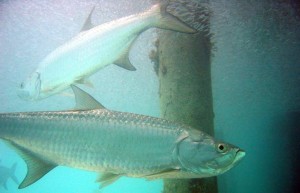So your a beginner fisherman and you want to land a “Morning Monster”; AKA Tarpon. Be forewarned they grow quite large and you may want to consider starting off with a smaller saltwater fish like, bluefish, Scup or even striped bass. But if you have your heart set on landing a lunker on your first trip, hopefully the advice below will help you accomplish that. You will have to invest some money into some larger tackle however. The tackle and or charter ride may set you back a couple hundred, but having a trophy Tarpon mounted on your wall may make it worth the investment.

Tarpon Fishing Facts
Tarpon can grow quite large some ranging over 8 feet long weighing 300 lbs plus. Their large mouths and massive tails make them a very impressive catch to brag about to your friends. They are an anadromous fish, which means that they can live in both freshwater and saltwater. They use their air bladder to help them with buoyancy as well as an additional air supply while they are in waters with low oxygen. They are found mostly in saltwater, but can be found in freshwater rivers and marshes. Their very large flashy scales make them very distinguishable especially when they come to the surface and "roll" to grab a gulp of air. Many anglers that study Tarpon anticipate this behavior and use it for their advantage while trying to locate Tarpon.
Tarpon are known to be cannibalistic but will feed mostly on other fish species like alewives, minnows, menhaden, mackerel or whatever bait-fish is plentiful at the time.
They do not have any teach with makes them easier to handle once out of the water. Anglers often hoist them from the water by their lower jaw using only a glove. Never attempt this with a bluefish or other species that you know has razor sharp teeth.
Once caught they put on quite the acrobatic display leaping many feet in into the air.
Their overall length is also an asset to them as they can use their lateral line system to hone in on a struggling fishes vibration.
How to catch Tarpon

Tarpon can be caught by a variety of methods. One such method is called “live lining” which involves attaching a live bait to the end of the line. Such bait could be Menhaden, Crabs, Pin fish or Mullet. Most anglers will try to hook a medium sized hook behind the dorsal fin ot the bait fish. Tarpon will attempt to swallow their meals headfirst with one large gulp as they do not have teach to chew their meals. Some anglers will place their hook a few feet down from a float dobber so they can keep an eye on their line when a big one bites. Depending on how deep the fish are will determine if you need a dobber or a small weight. They generally are not found very deep in the water column however so try to keep your bait near the surface.
Tarpon can also be caught trolling or casting. Casting is the preferred method as they can be easily spooked by a running motor. Any larger multicolored plug or swim-bait can be effective. Most Tarpon can be found within a few miles from shore.
What is the best bait for Tarpon Fishing
Study the fish species that are in your current location and understand what the Tarpon are currently feeding on. Try to match your color, size and shape to what they are currently feeding on.
Any smaller fish or even insect imitations can be used to catch smaller Tarpon. Fly Fishing for Tarpon is becoming more and more popular as time progresses. Pin-fish, Sardines and crabs seem to be the most popular baits that are bought at the local bait shops.
Where to catch Tarpon
Tarpon can be caught along the Eastern Sea Shore from Georgia to South America and parts of the Gulf. Many anglers are concerned about the Tarpon populations due to the recent oil spill disaster in the gulf. Generally anglers will target areas a few miles out from the shoreline. Bridges are also popular locations as they have been know to hide out in the shady areas during the midday sun.
Some Specific Areas include:
Jacksonville Florida
West Palm Beach Florida
Miami Florida
Florida Keys
Caribbean Islands
Panama City Florida
New Orleans Louisiana
Savannah Georgia
Richmond South Carolina
When is the best time to catch Tarpon
Tarpon are a nocturnal species so they are best caught in either the early morning or late in the evening. On a full moon they can also be caught throughout the night. Many anglers feel that the spring and summer months are the most active times to catch Tarpon.
Look for artificial lights when night fishing as they are attracted the light and they can easily spot prey fish with their good vision in low light conditions.


